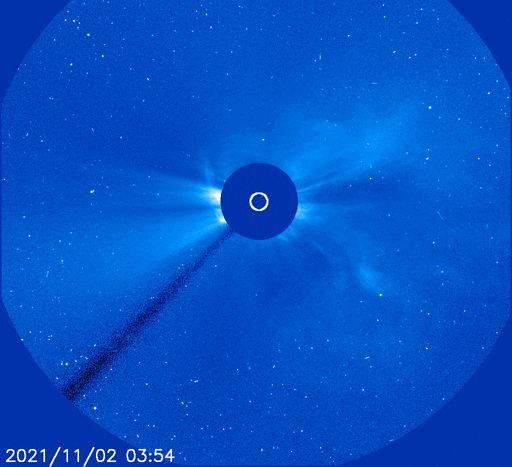Last week's powerful X-class flare from the sunspot, AR 2887, the first since September 2017, only grazed earth's magnetosphere on the 31st of October but caused a wonderful display of Aurora Borealis across most of the Northern Hemisphere as far south as England, Holland, and Germany in Europe. According to Spaceweather.com, the blast at 1535 UT on Oct. 28th created a massive tsunami of plasma in the sun's atmosphere.
AR 2887 has not gone away, yesterday it fired off another (special) CME, an M1.7-class "cannibal" solar flare, and this time the CME will hit Earth directly, see the animation above.
According to Spaceweather.com, the CME heading for Earth is a cannibal. SOHO coronagraphs recorded the CME leaving the sun on Nov. 2nd following a slow-motion solar flare (M1.7) in the magnetic canopy of sunspot AR2891:
Cannibal CMEs are fast coronal mass ejections that sweep up slower CMEs in front of them. Piled together, the mish-mash of CMEs contain strong magnetic fields and compressed plasmas that can do a good job sparking geomagnetic storms.
The slower CMEs, in this case, were hurled into space on Nov. 1st and 2nd by departing sunspot AR2887. NOAA analyst.
The animation shows the cannibal cloud sweeping up one whole CME and a portion of another. If NOAA's model is correct, the combined CME will make first contact with our planet around 2300 UT on Nov. 3rd, with geomagnetic storms commencing on Nov. 4th.
The model also predicts a +300 km/s increase in solar wind speed and a 5-fold jump in solar wind density in the CME's wake. These conditions, if they materialize, would set the stage for geomagnetic storms as strong as category G2. Yesterday's solar wind reached an impressive 600 km/s as it was blasted from the Sun.


These blasts from our sun are perfect examples of just how vulnerable and pathetic the evil technologies in this world truly are. That is all pending on electricity powering it and can be disabled in an instant. It gives me hope in a weird sort of way, but on the flip side of that it is troubling.
ReplyDeleteThe auroras seen so far south now from these blasts seem to indicate the reason they are being seen so far south now is due to the seriously lacking ozone protection layer of our atmosphere. They certainly coincide with where those holes are the worst. I recently saw information showing there is zero ozone now at the very tip of the bottom of earth, Antarctica. None, a complete void area of ozone! There is more then one ozone hole, and much of the surrounding areas spanning out from the holes are depleted much. Spanning out quite a distance.
Understand that it means extreme UV is penetrating upon us without ozone protection.
Thanks for keeping us updated on these solar storms Gary!
Your welcome Hawkeye.
ReplyDeleteWe need to realize. Extreme solar storms pose a threat to all forms of high technology. They begin with an explosion--a "solar flare"—in the magnetic canopy of a sunspot. X-rays and extreme UV radiation reach Earth at light speed, ionizing the upper layers of our atmosphere; side-effects of this "solar EMP" include radio blackouts and GPS navigation errors. Minutes to hours later, the energetic particles arrive. Moving only slightly slower than light itself, electrons and protons accelerated by the blast can electrify satellites and damage their electronics. Then come the CMEs, billion-ton clouds of magnetized plasma that take a day or more to cross the Sun-Earth divide. Analysts believe that a direct hit by an extreme CME such as the one that missed Earth in July 2012 could cause widespread power blackouts, disabling everything that plugs into a wall socket. Most people wouldn't even be able to flush their toilets because urban water supplies largely rely on electric pumps. Full story
To make matters worse, geologists have been expressing concerns about the magnetic field that shields Earth from deadly solar radiation. In 2019, when the US National Oceanic and Atmospheric Administration was forced to update its World Magnetic Model a year early after finding that the magnetic north pole was rapidly moving out of the Canadian Arctic and toward Siberia.
The US National Aeronautics and Space Administration is tracking an immense, growing, and slowly splitting "dent" in the Earth's Magnetic field. The area, known as the South Atlantic Anomaly, is situated in the southern hemisphere between South America and the southern Atlantic Ocean off the coast of southwestern Africa. According to recent NASA monitoring and modeling, the area is expanding westward and becoming weaker and expected to completely split into two separate cells, each spanning thousands of kilometers across, very soon.
The question here folks is, "when," and not if...